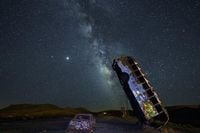A spacecraft built like a tank that was supposed to study Venus has likely crashed back to Earth Saturday morning, May 10, 2025, decades after its Soviet-era launch. Space agencies had tracked the defunct probe, known alternatively as Kosmos 482, Cosmos482, or 05919, and estimated on Friday, May 9, that it would reenter Earth's atmosphere in the overnight hours of Friday night into Saturday morning, Eastern Time.
The European Space Agency confirmed that the spacecraft reentered Earth's atmosphere around 2 a.m. ET on Saturday, May 10, 2025. However, there are no reports yet of where the spacecraft may have landed or if it even survived reentry. A map from the European Union's Space Surveillance and Tracking site showed Kosmos 482's final orbit was on a path over the Atlantic Ocean, then over Europe and into southwestern Asia.
Kosmos 482, also known as Cosmos482 or 05919, was a Venus-bound probe that launched atop a Russian Soyuz rocket on March 31, 1972. Unfortunately, after reaching Earth orbit, the satellite failed to launch on a trajectory toward Venus. Kosmos 482 then broke into four sections—two of which remained in Earth’s orbit for just 48 hours, and two larger pieces that have been circling Earth ever since. Part of the probe, with its half-ton titanium shell, has been in an elliptical Earth orbit for decades.
NASA and European tracking groups had narrowed down the window when Kosmos 482 was expected to hit Earth. For weeks, the space agencies have been running models to see when – and where – the failed satellite would come down. Because the probe was designed to withstand the immense heat within Venus’ atmosphere, experts suggested it was possible that it would survive reentry and reach Earth’s surface.
The EU SST stated that the spacecraft, made with a titanium shell, "may survive and reach the ground almost intact." Experts with Aerospace Corp's Center for Orbital and Reentry Debris Studies (CORDS) assessed that any individual was more likely to be struck by lightning than injured by Cosmos482. "If it remains intact all the way to the surface, we project a risk of 0.4 in 10,000 — which falls well within the current safety threshold," Aerospace wrote this week.
In recent weeks, the spacecraft known as Kosmos-482 had been making an uncontrolled approach towards Earth. Experts had been tracking it, noting that it was very unlikely that it would land over a populated area. Now, the European Space Agency and others confirmed that the spacecraft had most likely hit the Earth. It was not spotted on its most recent pass over radar in Germany, leading to predictions that it had already fallen to Earth.
Originally made to land on Venus, Kosmos-482 was hit by technical problems during its launch and got stuck in orbit around Earth. For the 53 years since, it has been floating around our planet until its orbit collided with the Earth. Experts speculated that since the spacecraft was designed to land on the hot and high-pressure planet of Venus, it could have survived the descent through Earth’s atmosphere, rather than breaking up like many other uncontrolled descents.
Marcin Pilinski, a scientist from the University of Colorado Boulder, noted that the odds of it slamming into a populated area are "infinitesimally small." He explained, "While we can anticipate that most of this object will not burn up in the atmosphere during re-entry, it may be severely damaged on impact." By Friday, all indications pointed to a re-entry early on Saturday morning, US Eastern Time, give or take several hours.
As of Friday morning, May 9, 2025, the spacecraft was expected to reenter Earth’s atmosphere around 2:26 ET on Saturday, according to the European Space Agency. The Aerospace Corporation estimated a similar time frame, placing the craft’s reentry closer to 1:50 a.m. ET on Saturday. The current landing zone prediction was between 52° North and 52° South of the equator—essentially, most of the Earth’s surface, including Africa, Australia, a majority of the Americas, and plenty of South Asia and Europe.
Experts from the Aerospace Corporation’s Center for Orbital and Reentry Debris Studies have said that it’s far more likely for a person to be struck by lightning than to be hurt by the Soviet spacecraft. "If it remains intact all the way to the surface, we project a risk of 0.4 in 10,000 — which falls well within the current safety threshold," they stated.
The Kosmos-482 spacecraft, part of the U.S.S.R's Venera program, was developed to research the planet Venus. The rocket carrying Kosmos 482 malfunctioned, and its upper stage got stuck in Earth orbit. Over the following fifty-three years, the approximately three-foot wide, 1,069-pound spacecraft circled the Earth in an ever-smaller elliptical orbit until it came close enough to fall into the planet's atmosphere.
It is not unusual for space junk to fall back to Earth. More than 2,400 human-made objects fell from space in 2022, a record number according to ESA. The vast majority of them burned up in Earth's atmosphere, and most of those that didn't splashed into an ocean. However, Kosmos 482 was built to withstand a descent through Venus' dense atmosphere, and to operate on the planet's surface, where the mean temperature is 867 degrees Fahrenheit (464 C). This meant it was theoretically hardy enough to survive a comparatively easy re-entry through Earth's atmosphere.
There’s no record of space debris ever causing a human fatality. ESA officials wrote in a blog post about Kosmos-482, "The risk of any satellite reentry causing injury is extremely remote. The annual risk of an individual human being injured by space debris is under 1 in 100 billion. In comparison, a person is about 65,000 times more likely to be struck by lightning." On Friday, the U.S. Space Force forecasted that the spacecraft would re-enter the atmosphere at 1:52 a.m. ET on Saturday morning above the Pacific Ocean, west of Guam.
Any surviving wreckage from Kosmos 482 will belong to Russia under a United Nations treaty. As the world waits to hear more about the fate of this decades-old spacecraft, its journey serves as a reminder of the complex and often unpredictable nature of space exploration.


